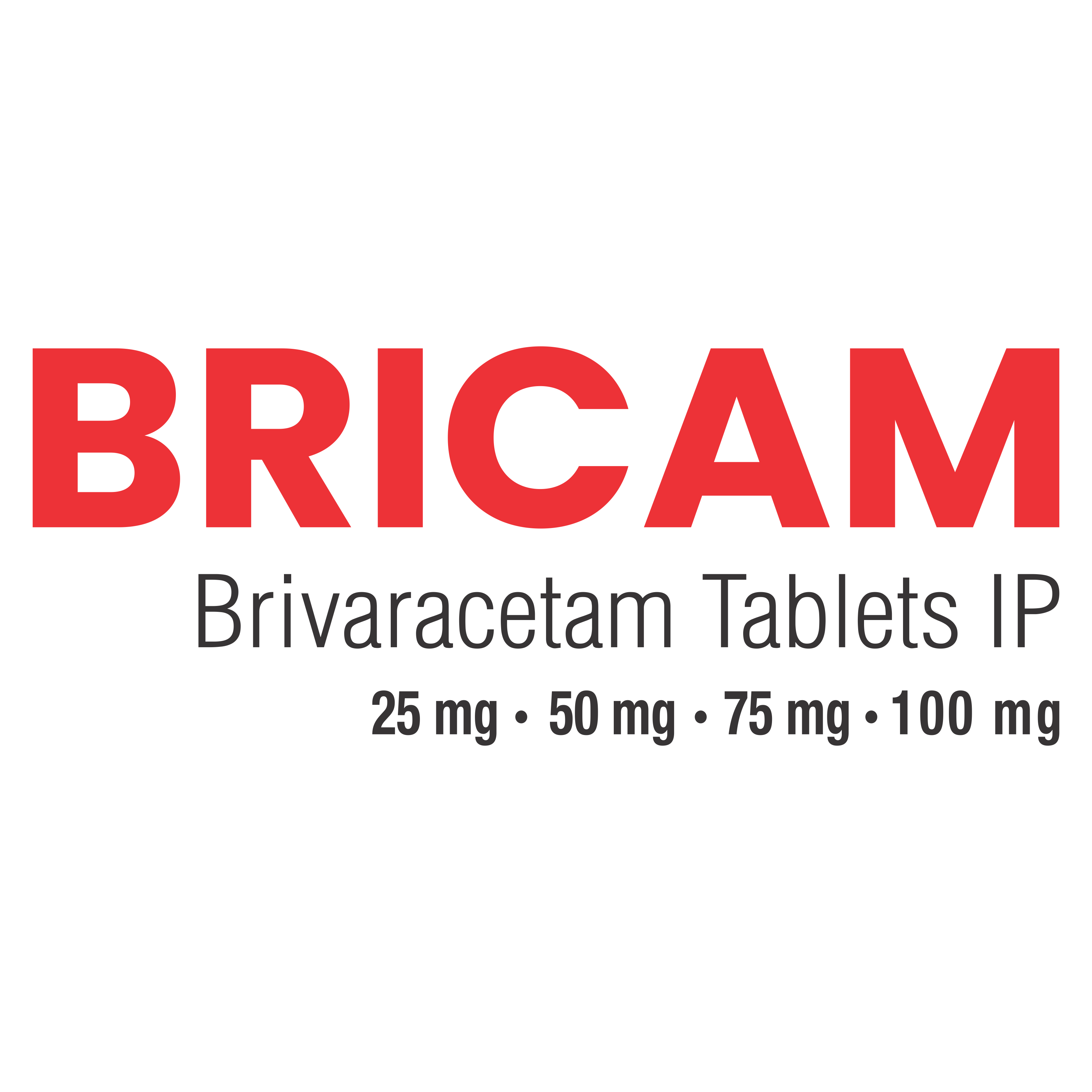BRICAM
| Generic Name | Brivaracetam Tablets IP |
| Strength | 25, 50, 75, 100mg |
| Dosage Form | Tablets |
Description
BRICAM contains the active substance Brivaracetam. It belongs to a group of medicines called ‘anti-epileptics’.
PATIENT INFORMATION LEAFLET
Read all of this leaflet carefully before you start taking this medicine because it contains important
information for you.
– Keep this leaflet. You may need to read it again.
– If you have any further questions, ask your doctor or pharmacist.
– This medicine has been prescribed for you only. Do not pass it on to others. It may harm them, even if their
signs of illness are the same as yours.
– If you get any side effects, talk to your doctor or pharmacist. This includes any possible effects not listed
in this leaflet.
What is in this leaflet
1. What Bricam is and what it is used for
2. What you need to know before you take Bricam
3. How to take Bricam
4. Possible side effects
5. How to store Bricam
6. Contents of the pack and other information
1. What Bricam is and what it is used for
Bricam contains the active substance Brivaracetam. It belongs to a group of medicines called ‘anti-
epileptics’. These medicines are used to treat epilepsy.
- Bricam is used in adults, adolescents and children from 2 years of age.
- It is used to treat a type of epilepsy that has partial seizures with or without a secondary generalisation.
- Partial seizures are fits that start by only affecting one side of the brain. These partial seizures can spread
and extend to larger areas on both sides of the brain – this is called a ‘secondary generalisation’. - You have been given this medicine to lower the number of fits (seizures) you have.
- Bricam is used together with other medicines for epilepsy.
2. What you need to know before you take Bricam
- Do not take Bricam if:
- you are allergic to Brivaracetam, other similar chemical compounds as levetiracetam or piracetam or any
of the other ingredients of this medicine .If you are not sure, talk to your doctor or pharmacist before
taking Bricam.
Warnings and precautions
Talk to your doctor or pharmacist before taking Bricam if:
- You have thoughts of harming or killing yourself. A small number of people being treated with anti-
epileptic medicines such as Bricam have had thoughts of harming or killing themselves. If you have any
of these thoughts at any time, contact your doctor immediately. - You have liver problems – your doctor may need to adjust your dose.
Children
Bricam is not recommended for use in children under 2 years of age.
Other medicines and Bricam
Tell your doctor or pharmacist if you are taking, have recently taken or might take any other medicines.
In particular, tell your doctor if you are taking any of the following medicines – this is because your doctor
may need to adjust your Bricam dose:
- Rifampicin – a medicine used to treat bacterial infections.
- St John’s wort (also known as Hypericum perforatum) – a herbal medicine used to treat depression andanxiety as well as other conditions.
Bricam with alcohol
- Combining this medicine with alcohol is not recommended.
- If you drink alcohol while taking Bricam the negative effects of alcohol may be increased.
Pregnancy and breast-feeding
Fertile women should discuss the use of contraceptives with the doctor.
If you are pregnant or breast-feeding, think you may be pregnant or planning to have a baby, ask your doctor
or pharmacist for advice before taking this medicine.
It is not recommended to take Bricam if you are pregnant, as the effects of Bricam on pregnancy and the
unborn baby are not known.
It is not recommended to breast-feed your baby while taking Bricam, as Bricam passes into breast milk.
Do not stop treatment without talking to your doctor first. Stopping treatment could increase your seizures
and harm your baby.
Driving and using machines
- You may feel sleepy, dizzy or tired while taking Bricam.
- These effects are more likely at the start of the treatment or after a dose increase.
- Do not drive, cycle or use any tools or machines until you know how the medicine affects you.
Bricam contains lactose and sodium
Bricam film-coated tablets contain:
- lactose (a type of sugar) – If you have been told by your doctor that you have an intolerance to some
sugars, contact your doctor before taking this medicine. - sodium – This medicine contains less than 1 mmol sodium (23mg) per tablet, that is to say essentially
‘sodium free’.
3. How to take Bricam
Always take this medicine exactly as your doctor has told you. Check with your doctor or pharmacist if you
are not sure. Other form(s) of this medicine may be more suitable for certain patients e.g. children (if tablets
can not be swallowed in whole, for example); ask your doctor or pharmacist. You will take Bricam together
with other medicines for epilepsy.
How much to take
Your doctor will work out the right daily dose for you. Take the daily dose in two equal divided doses,
approximately 12 hours apart.
Adolescents and children weighing 50 kg or more, and adults
- The recommended dose is from 25 mg to 100 mg taken twice a day. Your doctor may then decide to
adjust your dose to find the best dose for you.
Adolescents and children weighing from 20 kg to less than 50 kg - The recommended dose is from 0.5 mg to 2 mg for each kg of bodyweight, taken twice a day.
Your doctor may then decide to adjust your dose to find the best dose for you.
Children weighing from 10 kg to less than 20 kg - The recommended dose is from 0.5 mg to 2.5 mg for each kg of bodyweight, taken twice a day.
Your child’s doctor may then decide to adjust your child’s dose to find the best dose for your child.
People with liver problems
If you have problems with your liver: - As an adolescent or child weighing 50 kg or more, or as an adult, the maximum dose you will take is 75
mg twice a day. - As an adolescent or child weighing from 20 kg to less than 50 kg, the maximum dose you will take is 1.5
mg for each kg of bodyweight twice a day. - As a child weighing from 10 kg to less than 20 kg, the maximum dose your child will take is 2 mg foreach kg of bodyweight twice a day.
How to take Bricam tablets
- Swallow the tablets whole with a glass of liquid.
- The medicine may be taken with or without food.
How long to take Bricam for
Bricam is a long term treatment – keep taking Bricam until your doctor tells you to stop.
If you take more Bricam than you should
If you have taken more Bricam than you should, talk to your doctor. You may feel dizzy and sleepy. You
may also have any of the following symptoms: feeling sick, a feeling of ‘spinning’, problems of keeping
your balance, anxiety, feeling very tired, irritability, being aggressive, not being able to sleep, depression,
thoughts or attempts of harming or killing yourself.
If you forget to take Bricam
- If you miss a dose take it as soon as you remember.
- Then take your next dose at the time you would normally take it.
- Do not take a double dose to make up for a forgotten dose.
- If you are not sure what to do, ask your doctor or pharmacist.
If you stop taking Bricam
- Do not stop taking this medicine unless your doctor tells you to. This is because stopping treatment
could increase the number of fits you have. - If your doctor asks you to stop taking this medicine, they will lower your dose gradually. This helps to
stop your fits coming back or getting worse. - If you have any further questions on the use of this medicine, ask your doctor or pharmacist.
4. Possible side effects
Like all medicines, this medicine can cause side effects, although not everybody gets them.
Very common: may affect more than 1 in 10 people
- Feeling sleepy or dizzy
Common: may affect up to 1 in 10 people - Flu
- Feeling very tired (fatigue)
- Convulsion, a feeling of ‘spinning’ (vertigo)
- Feeling and being sick, constipation
- Depression, anxiety, not being able to sleep (insomnia), irritability
- Infections of the nose and throat (such as the ‘common cold’), cough
- Decreased appetite
Uncommon: may affect up to 1 in 100 people - Allergic reactions
- Abnormal thinking and/or loss of touch with reality (psychotic disorder), being aggressive, nervous
excitement (agitation) - Thoughts or attempts of harming or killing yourself: tell your doctor straight away
- A decrease in white blood cells (called ‘neutropenia’) – shown in blood tests
Additional side effects in children
Common: may affect up to 1 in 10 people
Restlessness and hyperactivity (psychomotor hyperactivity)
Reporting of side effects
If you get any side effects, talk to your doctor or pharmacist. This includes any possible side effects not
listed in this leaflet.
5. How to store Bricam
- Keep this medicine out of the sight and reach of children.
- Do not use this medicine after the expiry date which is stated on the carton and blister after EXP.
- The expiry date refers to the last day of that month.
- This medicinal product does not require any special storage conditions.
- Do not throw away any medicines via wastewater or household waste. Ask your pharmacist how to throw away medicines you no longer use. These measures will help protect the environment.
6. Contents of the pack and other information
What Bricam contains
The active substance is Brivaracetam.
Each film-coated tablet contains 25 mg, 50 mg, 75 mg, or 100 mg Brivaracetam.
Bricam 25
Each film coated tablet contains:
Brivaracetam IP 25 mg
Colours: Iron Oxide Black, Iron Oxide Yellow & Titanium Dioxide
Bricam 50
Each film coated tablet contains:
Brivaracetam IP 50 mg
Colours: Iron Oxide Yellow & Titanium Dioxide
Bricam 75
Each film coated tablet contains:
Brivaracetam IP 75 mg
Colours: Iron Oxide Black, Iron Oxide Red & Titanium Dioxide
Bricam 100
Each film coated tablet contains:
Brivaracetam IP 100 mg
Colours: Sunset Yellow Lake & Titanium Dioxide
What Bricam looks like and contents of the pack
Bricam 25 mg are grey, round, biconvex, film coated tablets with breakline on one side. The pack size is 10
x 10 in Alu-Alu Blister. 10 tablets are packed in a strip using HSL coated printed aluminium foil on one side
and plain cold form foil consisting of three layers (PVC, Aluminium and Nylon) on the other side.
Bricam 50 mg are yellow, round, biconvex, film coated tablets with breakline on one side. The pack size is
10 x 10 in Alu-Alu Blister. 10 tablets are packed in a strip using HSL coated printed aluminium foil on one
side and plain cold form foil consisting of three layers (PVC, Aluminium and Nylon) on the other side.
Bricam 75 mg are red, round, biconvex, film coated tablets with breakline on one side. The pack size is 10 x
10 in Alu-Alu Blister. 10 tablets are packed in a strip using HSL coated printed aluminium foil on one side
and plain cold form foil consisting of three layers (PVC, Aluminium and Nylon) on the other side.
Bricam 100 mg are orange, oblong, biconvex, film coated tablets. The pack size is 10 x 10 in Alu-Alu
Blister. 10 tablets are packed in a strip using HSL coated printed aluminium foil on one side and plain cold
form foil consisting of three layers (PVC, Aluminium and Nylon) on the other side.





